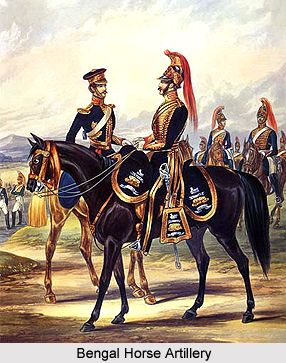 The Bengal Horse Artillery was one of the former elite regiments of the British Indian Army. The army unit was raised as the Experimental Brigade of Bengal Horse Artillery by the British East India Company in 1800. The artillery regiment served under the administrative control of the Bengal Army of Bengal Presidency till 1895. Later the unit was incorporated as apart of the British Indian Army that was formed by the amalgamation of the 3 Presidency Armies in British India. The Bengal Horse Artillery was served as a sub-division of the Bengal Artillery regiment.
The Bengal Horse Artillery was one of the former elite regiments of the British Indian Army. The army unit was raised as the Experimental Brigade of Bengal Horse Artillery by the British East India Company in 1800. The artillery regiment served under the administrative control of the Bengal Army of Bengal Presidency till 1895. Later the unit was incorporated as apart of the British Indian Army that was formed by the amalgamation of the 3 Presidency Armies in British India. The Bengal Horse Artillery was served as a sub-division of the Bengal Artillery regiment.
In 1809, the 2nd Troop of Bengal Horse Artillery and the 3rd Troop of Bengal Horse Artillery were formed. Later in the year 1917, three native battalions were raised by the British Empire in India. These three brigades consisted of only native soldiers. However in 1826, Bengal Horse Artillery was re-grouped and re-structured into Brigades. The regiment was became apart of the Royal Artillery in 1861.
The troops of the Bengal Horse Artillery took part in several military operations and campaigns under the British administration. The unit fought in the Second Anglo Maratha War from 1803 to 1805. It also provided active military service during the Gurkha War from 1814 to 1816. The artillery unit also participated in the Siege of Hattress during the Third Anglo Maratha War in 1817. From 1823 to 1826, the Bengal Horse Artillery fought in the Burma War. Later the troops also took part in the First Anglo Afgan War.
This article is a stub. You may enrich it by adding more information to it. You can send your write-up at content@indianetzone.com



















